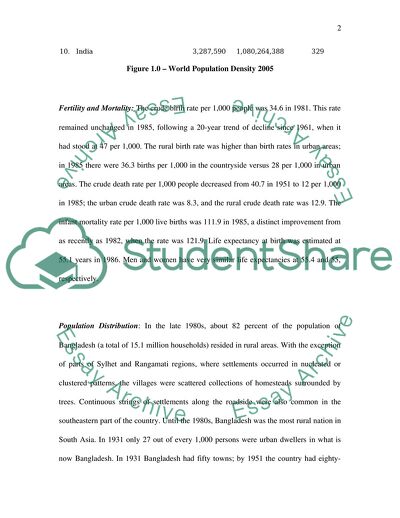
- Home
- Free Samples
- Premium Essays
- Editing Services
- Extra Tools
- Essay Writing Help
- About Us
- Studentshare
- Subjects
- Miscellaneous
- Geography Analysis
Geography Analysis - Essay Example

- Subject: Miscellaneous
- Type: Essay
- Level: Undergraduate
- Pages: 4 (1000 words)
- Downloads: 0
- Author: hanehans
Extract of sample "Geography Analysis"
he rural birth rate was higher than birth rates in urban areas; in 1985 there were 36.3 births per 1,000 in the countryside versus 28 per 1,000 in urban areas. The crude death rate per 1,000 people decreased from 40.7 in 1951 to 12 per 1,000 in 1985; the urban crude death rate was 8.3, and the rural crude death rate was 12.9. The infant mortality rate per 1,000 live births was 111.9 in 1985, a distinct improvement from as recently as 1982, when the rate was 121.9. Life expectancy at birth was estimated at 55.
1 years in 1986. Men and women have very similar life expectancies at 55.4 and 55, respectively. Population Distribution: In the late 1980s, about 82 percent of the population of Bangladesh (a total of 15.1 million households) resided in rural areas. With the exception of parts of Sylhet and Rangamati regions, where settlements occurred in nucleated or clustered patterns, the villages were scattered collections of homesteads surrounded by trees. Continuous strings of settlements along the roadside were also common in the southeastern part of the country.
Until the 1980s, Bangladesh was the most rural nation in South Asia. In 1931 only 27 out of every 1,000 persons were urban dwellers in what is now Bangladesh. In 1931 Bangladesh had fifty towns; by 1951 the country had eighty-nine towns, cities, and municipalities. During the 1980s, industrial development began to have a small effect on urbanization. The 1974 census had put the urban population of Bangladesh at 8.8 percent of the total; by 1988 that proportion had reached 18 percent and was projected to rise to 30 percent by the year 2000.
Urbanization: In 1981 only two cities, Dhaka and Chittagong, had more than 1 million residents. Seven other cities--Narayanganj, Khulna, Barisal, Saidpur, Rajshahi, Mymensingh, and Comilla--each had more than 100,000 people. Of all the expanding cities, Dhaka, the national capital and the principal seat of culture, had made the most gains in population, growing from 335,928
...Download file to see next pages Read MoreCHECK THESE SAMPLES OF Geography Analysis
Human Geography Analysis
Human Geography: Affect and Emotion
African Geography and Growth
Geographic Information Systems and Spatial Analysis
Political Speeches and Press Releases
Development and Formation of Transport Geography
Geography
UK Markets: Place and Flow Issues

- TERMS & CONDITIONS
- PRIVACY POLICY
- COOKIES POLICY